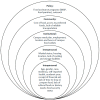Food Security Characteristics Vary for Undergraduate and Graduate Students at a Midwest University
- PMID: 34073623
- PMCID: PMC8197841
- DOI: 10.3390/ijerph18115730
Food Security Characteristics Vary for Undergraduate and Graduate Students at a Midwest University
Abstract
The study objective was to determine prevalence of food insecurity and its associations with socioecological model (SEM) characteristics for undergraduate and graduate students. An online questionnaire was distributed to a convenience sample of students aged 18-34 at a Midwestern university. Of the 938 responses, 675 were complete for analysis. Outcome measures included demographics, food security level, housing, food access barriers, coping strategies, and food assistance program usage. Results found that predictors associated with undergraduate food insecurity included non-White race, receipt of financial aid, lower self-reported health status, living off-campus, employment, and food cost (p < 0.001). Graduate student food insecurity was associated with Asian self-identification, employment, food cost, no time to prepare foods, and lack of foods for dietary needs (p < 0.001). Students with food insecurity were more likely to buy cheap food (p < 0.001). Almost 50% of food-insecure undergraduates asked friends or family to help buy food. Food-insecure students were more likely to want information on meal preparation and budgeting. More graduate students were likely to know of and use food pantries. Overall, food insecurity was higher among undergraduate than graduate students. Universities should consider institutional and policy changes tailored to the separate populations to mitigate the prevalence of campus food insecurity.
Keywords: college students; food environment; food insecurity; socioecological model; young adults.
Conflict of interest statement
The authors declare no conflict of interest.
Figures
References
-
- An Introduction to the Basic Concepts of Food Security. Food and Agriculture Organization. [(accessed on 18 July 2020)]; Available online: http://www.fao.org/docrep/013/al936e/al936e00.pdf.
Publication types
MeSH terms
LinkOut - more resources
Full Text Sources


